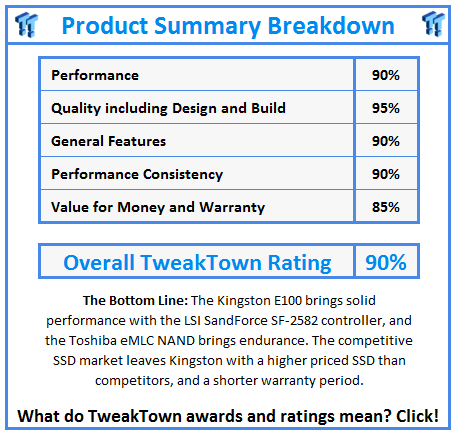Introduction
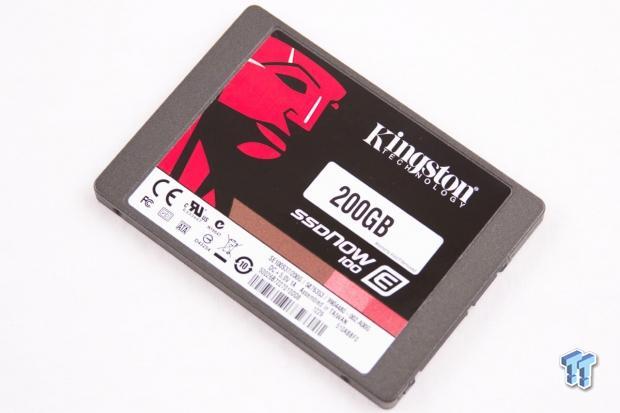
Kingston's humble roots began with just one memory product back in 1987. With time, and a focus on quality and reliability, they have expanded into the world's largest independent manufacturer of memory products. Kingston's stellar reputation for quality products and service after the sale has secured them a large customer base in both the client and enterprise markets.
The Kingston SSDNow E100 is designed for entry-level enterprise applications and touts high endurance and admirable performance characteristics as its hallmarks. The reliable LSI SandForce SF-2500 enterprise-class controller in tandem with 32nm Toshiba eMLC Toggle NAND powers the SSDNow E100. This combination delivers 500MB/s in sequential read speed, and a tiered write speed depending upon the capacity utilized. The SSDNow E100 comes in capacities of 100GB, 200GB and 400GB; the largest provides 260MB/s in sequential write and the two smaller capacities sport a slightly lower 255MB/s write speed.
The Toshiba eMLC Toggle NAND is an important component that brings 30,000 P/E cycles into play. This durable NAND brings a tremendous amount of endurance to the table. Laying the solid foundation with high-endurance NAND is a great start, but any SSD is only as good as the controller.
The LSI SandForce controllers leverage DuraClass technology to extend the life of the SSD and provide enhanced speed. DuraWrite focuses around the use of compression logic that shrinks the amount of data written to the NAND. This provides a two-fold advantage, with less data written to the NAND users gain an appreciable boost in speed, and an accompanying increase of endurance, due to less NAND wear. Compressing the data also leaves extra free space on the NAND for the controller to use for its own purposes, helping to significantly lower write amplification. Many workloads in enterprise scenarios, such as database and OLTP applications, are composed of easily compressible data. This gives SandForce powered SSD's a tangible advantage in these environments.
Performance is not the most admirable trait in most deployments, reliability trumps all else. R.A.I.S.E. (Redundant Array of Silicon Elements) functionality is baked into all SandForce SSD's to protect the data on the NAND.
R.A.I.S.E is a NAND level redundancy scheme that uses one NAND die to provide parity data. Some manufacturers disable RAISE, and its accompanying data protection, in favor of gaining more capacity. There are also some current top-tier enterprise SSD's that do not provide data redundancy at the drive level. This extra level of data protection is critical in the majority of enterprise deployments.
The Kingston E100 rounds out its data protection features with end-to-end CRC protection and ECC recovery up to 55 bits correctable per 512-byte sector. This functionality is paired with a robust set of Tantalum capacitors that function well in high heat environments. This array of capacitors provide enough power to write any data in transit down to the NAND in the event of a host-power loss issue, and eliminates a single point of failure in the power hold-up solution.
Kingston SSDNow E100 Specifications
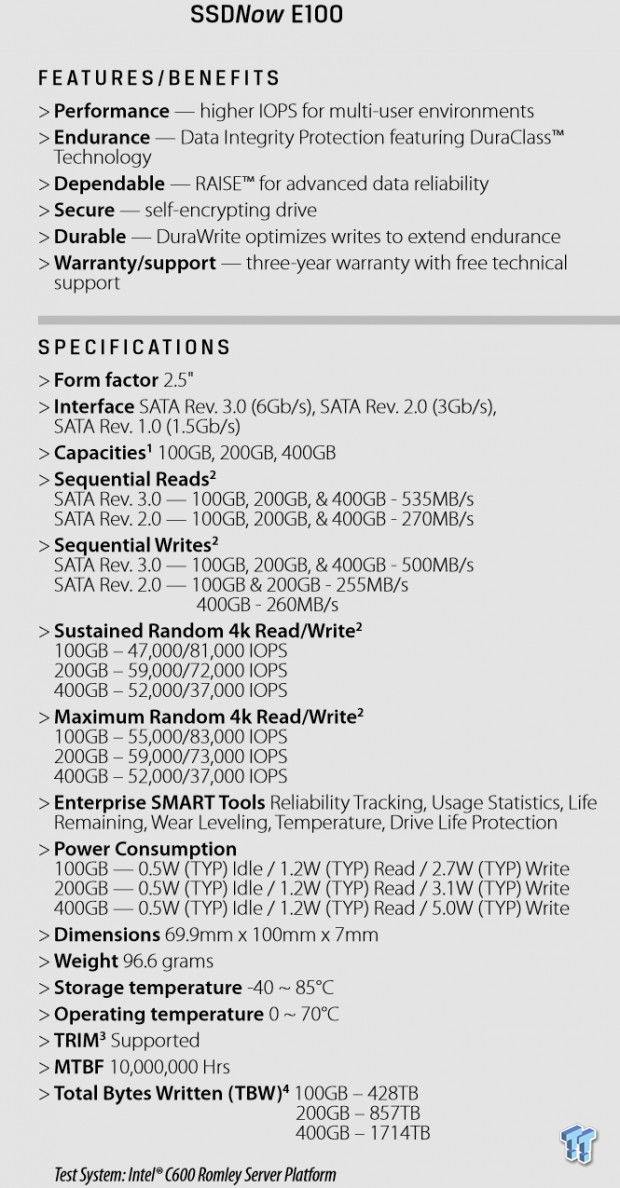
The 6Gb/s Kingston SSDNow comes in three capacities of 100GB, 200GB and 400GB. Each capacity features 428, 857, and 1714 TB of endurance, respectively. The endurance is enabled by 32nm Toshiba Toggle eMLC NAND with 30,000 P/E cycles, in conjunction with the LSI SandForce SF-2500 class controllers.
The SSD comes in a 2.5" form factor with a 7mm Z-Height, enabling the SSD to slip into dense applications. The SSD supports R.A.I.S.E functionality and 55-bit BCH ECC along with the standard SandForce equipped AES-128 encryption.
The Kingston E100 also features enhanced enterprise SMART monitoring statistics, which allows users to monitor reliability tracking, usage statistics and life remaining metrics.
The SSD is widely available and hovers around the $3.5 per GB price point. There is an included three year warranty, which is lower than the typical five year warranties which we are accustomed to in the enterprise space.
Kingston SSDNow E100 Internals
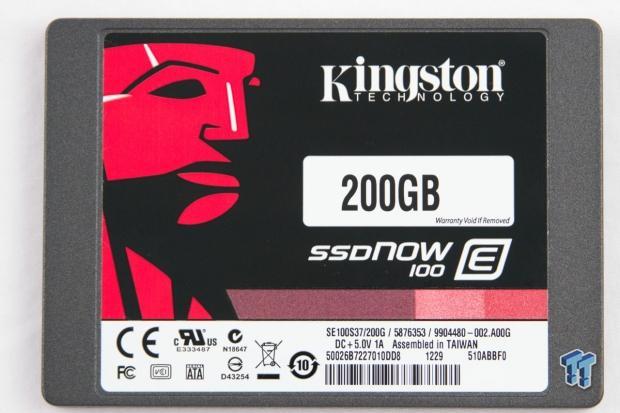
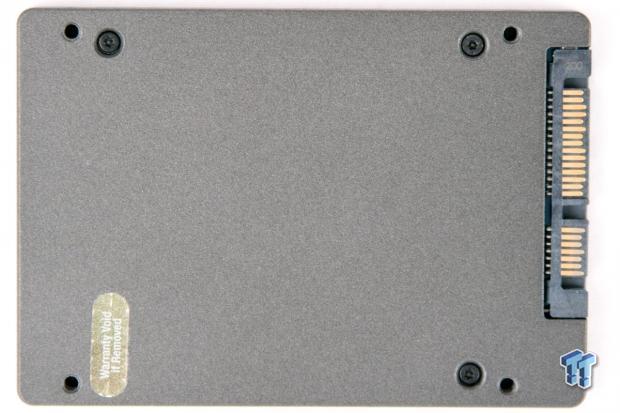
The Kingston SSDNow E100 comes in a heavy metal case that has plenty of heft to it. There is the relevant branding on the front of the case, and the rear is devoid of any markings.
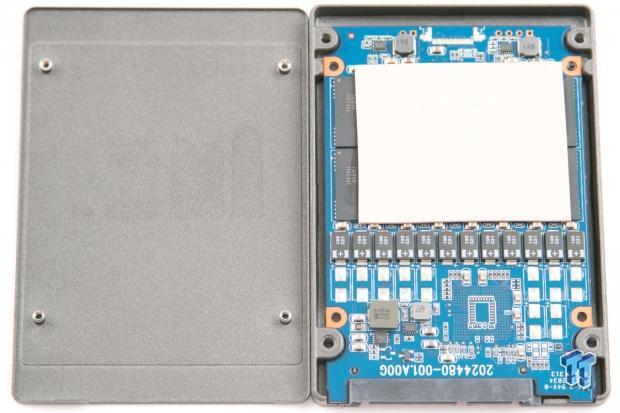
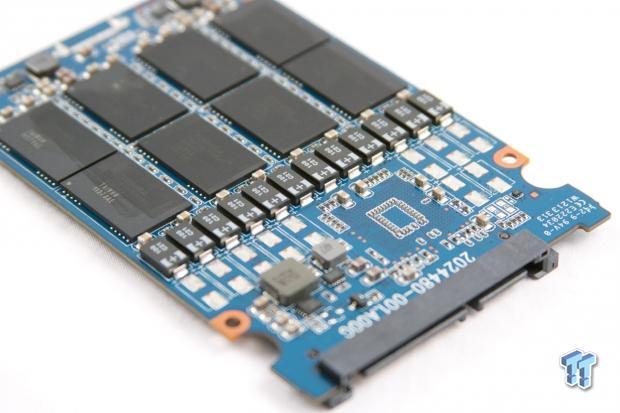
Once we get the SSDNow E100 open, we immediately notice the thick thermal pads affixed to the banks of NAND and the LSI SandForce controller. These thermal pads shed heat into the thick metal case, increasing the longevity of the SSD.
There is a row of Tantalum capacitors on the bottom of the PCB directly above the NAND packages. This type of arrangement is superior to some other supercapacitor applications we observe in SandForce SSD's.
Many manufacturers use one large supercap, which is less tolerant to heat and creates a single point of failure. Spreading out the Tantalum capacitors, and their high heat tolerance, creates a more reliable design.
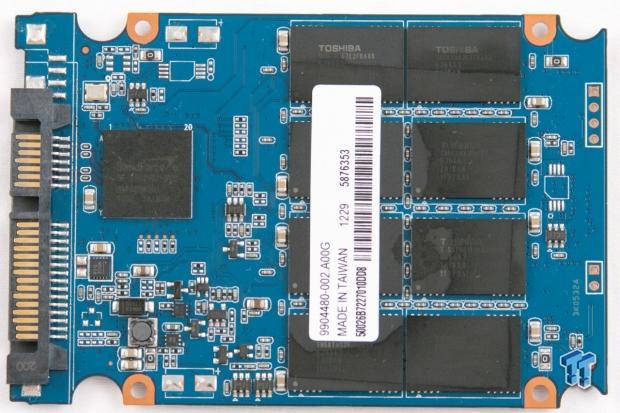
The LSI SandForce SF-2582 controller occupies the bottom of the PCB along with eight packages of 32nm eMLC Toshiba Toggle NAND. One NAND die is utilized to support R.A.I.S.E functionality, and after 28% of overprovisioning, the user is left with 128GB of addressable space.
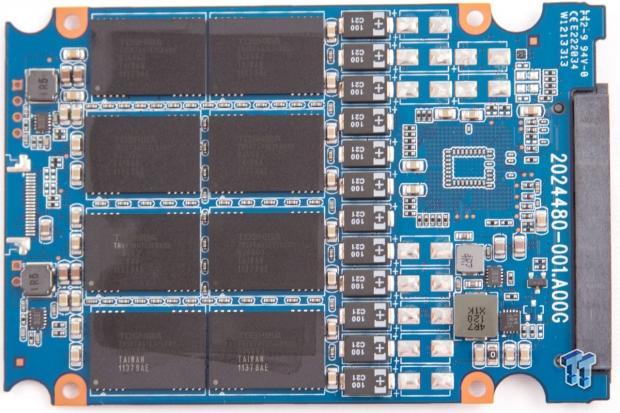
Eight more 16GB packages of eMLC Toshiba Toggle NAND occupy the bottom of the PCB, along with the array of Tantalum capacitors.
Test System and Methodology
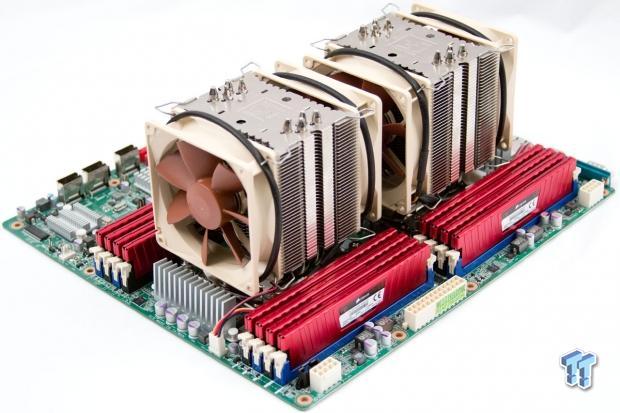

We utilize a new approach to HDD and SSD storage testing for our Enterprise Test Bench, designed specifically to target long-term performance with a high level of granularity.
Many testing methods record peak and average measurements during the test period. These average values give a basic understanding of performance, but fall short in providing the clearest view possible of I/O QoS (Quality of Service).
'Average' results do little to indicate the performance variability experienced during actual deployment. The degree of variability is especially pertinent, as many applications can hang or lag as they wait for I/O requests to complete. This testing methodology illustrates performance variability, and includes average measurements, during the measurement window.
While under load, all storage solutions deliver variable levels of performance. While this fluctuation is normal, the degree of variability is what separates enterprise storage solutions from typical client-side hardware. Providing ongoing measurements from our workloads with one-second reporting intervals illustrates product differentiation in relation to I/O QOS. Scatter charts give readers a basic understanding of I/O latency distribution without directly observing numerous graphs.
Consistent latency is the goal of every storage solution, and measurements such as Maximum Latency only illuminate the single longest I/O received during testing. This can be misleading, as a single 'outlying I/O' can skew the view of an otherwise superb solution. Standard Deviation measurements consider latency distribution, but do not always effectively illustrate I/O distribution with enough granularity to provide a clear picture of system performance. We use histograms to illuminate the latency of every single I/O issued during our test runs.
Our testing regimen follows SNIA principles to ensure consistent, repeatable testing. We attain steady state through a process that brings the device within a performance level that does not range more than 20% during the measurement window. Forcing the device to perform a read-write-modify procedure for new I/O triggers all garbage collection and housekeeping algorithms, highlighting the real performance of the solution.
We measure power consumption during precondition runs. This provides measurements in time-based fashion, with results every second, to illuminate the behavior of power consumption in steady state conditions. Power consumption can cost more over the life of the device than the initial acquisition price of the hardware itself. This significantly affects the TCO of the storage solution. We also present IOPS-to-Watts measurements to highlight the efficiency of the storage solution.
For LSI SandForce-powered SSD's we conduct all preconditioning, and the following workloads, with 50% compressible data. This is the result of industry feedback, and the middle ground provides a picture of performance that is neither too critical, nor too favorable. Readers must bear in mind that there is varying performance with LSI SandForce processors due to its internal compression engine. Incompressible data will score much lower than the results presented in these tests, and fully compressible data will score much higher. It is important for administrators to know their workload and select the storage solution accordingly.
Our test pool features SSD's of varying capacity, so it is important to bear this in mind when viewing results. The first page of results will provide the 'key' to understanding and interpreting our new test methodology.
4K Random Read/Write
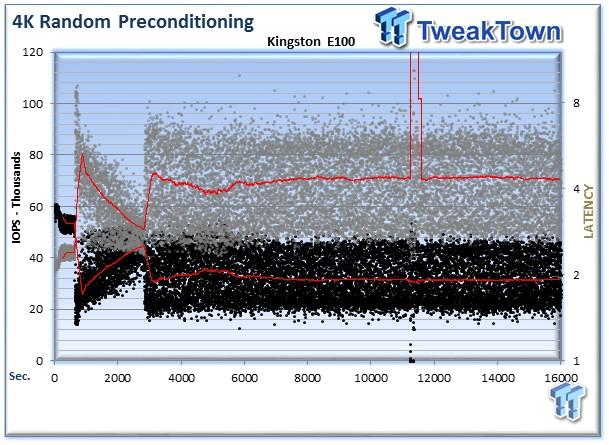
We precondition the Kingston SSDNow E100 with 50% compressible data for 18,000 seconds, or five hours, receiving reports on several parameters of workload performance every second. We then plot this data to illustrate the drives' descent into steady state. Please refer to the previous page for a note on data compressibility.
This chart consists of 36,000 data points. This is a dual-axis chart with the IOPS on the left and the latency on the right. The black dots signify IOPS during the test, and the brown dots are latency measurements during the test period. We place latency data in a logarithmic scale to bring it into comparison range. The lines through the data scatter are the average during the test. This type of testing presents standard deviation and maximum/minimum I/O in a visual manner.
Note that the IOPS and Latency figures are nearly mirror images of each other. This illustrates the point that high-granularity testing can give our readers a good feel for the latency distribution by viewing IOPS at one-second intervals. This should be in mind when viewing our test results below.
We provide histograms for further latency granularity below. This downward slope of performance happens very few times in the lifetime of the device, typically during the first few hours of use, and we present the precondition results only to confirm steady state convergence.
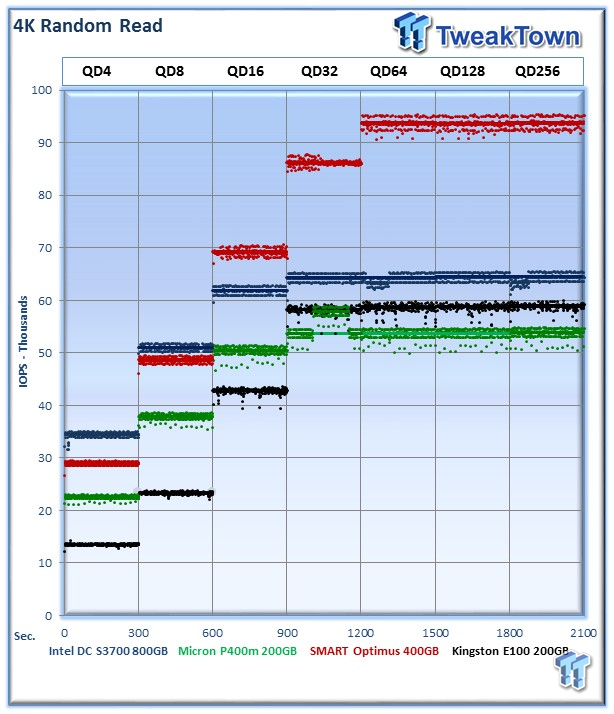
Each QD for every parameter tested includes 300 data points (five minutes of one second reports) to illustrate the degree of performance variability. The line for each QD represents the average speed reported during the five-minute interval.
4K random speed measurements are an important metric when comparing drive performance, as the hardest type of file access for any storage solution to master is small-file random. One of the most sought-after performance specifications, 4K random performance is a heavily marketed figure.
The Kingston SSDNow E100 averages 58,934 IOPS with a 4K random workload at QD256. This places it squarely between the Micron P400m and the Intel DC S3700.
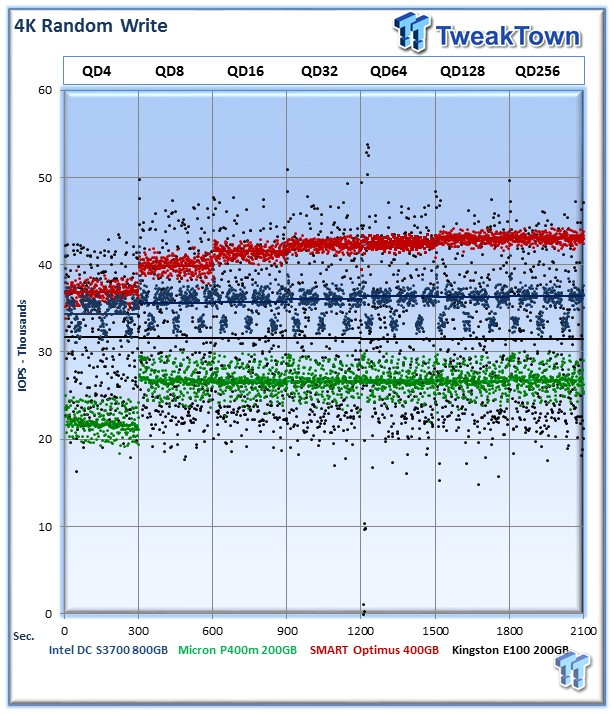
Garbage collection routines are more pronounced in heavy write workloads. This leads to more variability in performance. The SSDNow E100 has a wide performance variance, with operations occurring from above 50,000 IOPS to below 5,000 IOPS. This is due to the compression engine working furiously to compress the data as much as possible in the background. We are using 50% compressible data in all of our tests, and more compressible workloads experience significantly less variability.
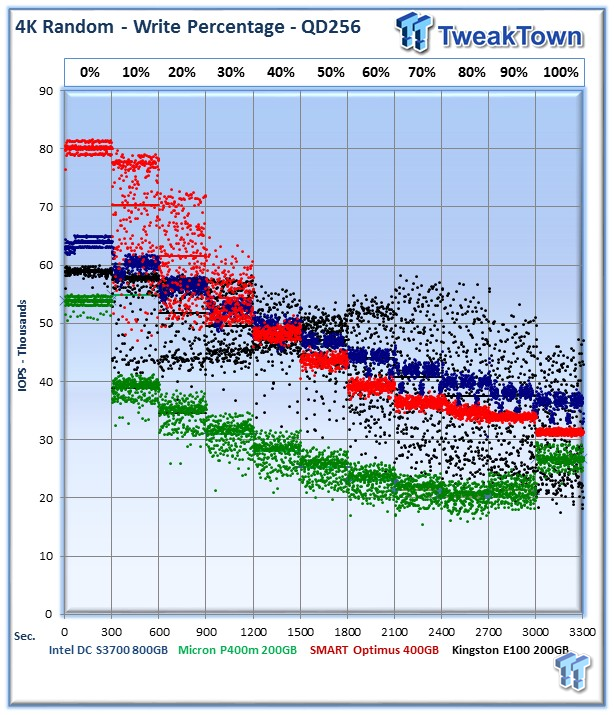
Our write percentage testing illustrates the varying performance of each solution with mixed workloads. The 100% column to the right is a pure write workload of the 4K file size, and 0% represents a pure 4K read workload.
The E100 provides a wide swath of performance across the varying workloads, with its peak performance measuring 60,000 IOPS with pure read data. The P400m does fall slightly lower in the 10-90% write testing.
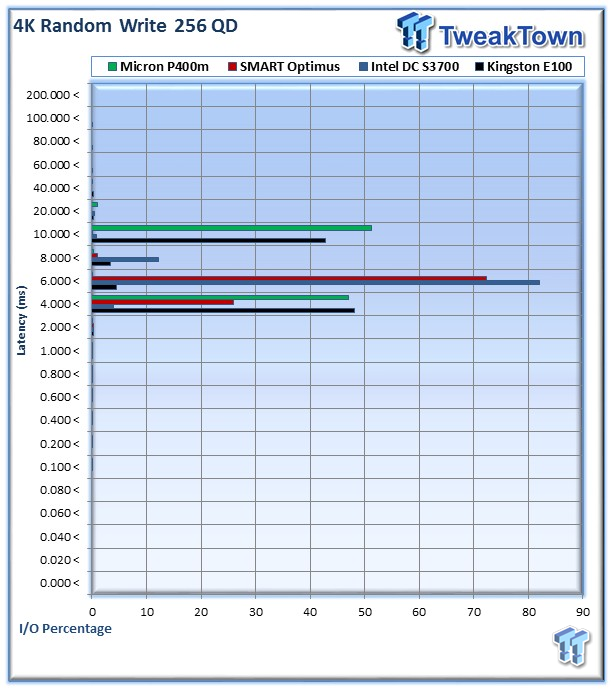
The Kingston E100 has 4,522,717 I/Os (48.0%) fall into the 4-6ms range, and 4,033,748 I/Os (42.8%) in the 10-20ms range.
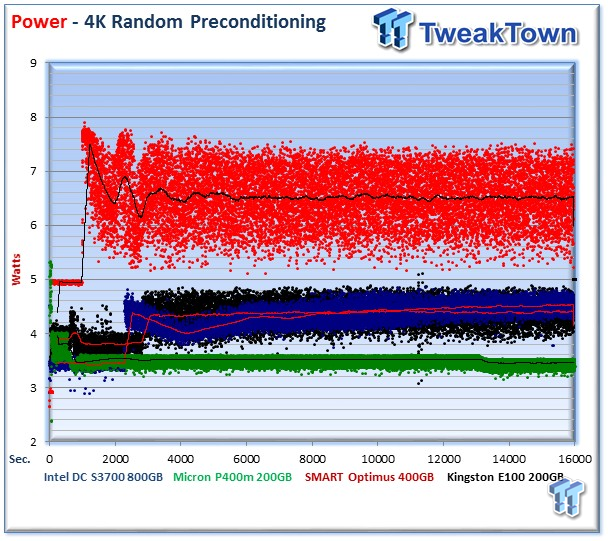
We record the power consumption measurements during our precondition run. We calculate the stated average results during the last five minutes of the test, after the device has settled into steady state.
The Kingston E100's power consumption during this test closely matches the Intel DC S3700. The Kingston E100 consumes an average of 4.5 Watts during the measurement window.
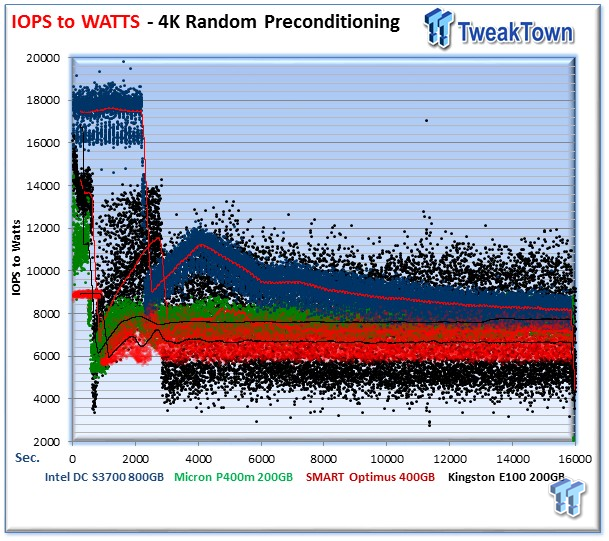
IOPS to Watts measurements are generated from data recorded during our precondition run, and the stated average is from the last five minutes of the test.
The Kingston E100's write performance variability leads to a scattered performance range that runs behind the other SSD's in the test pool. The Kingston E100 averages 7,117 IOPS per Watt, the P400m comes in very close with 7,624 IOPS per Watt, the Intel scores 8,336 IOPS per Watt and the Optimus scores 6,617 IOPS per Watt.
8K Random Read/Write
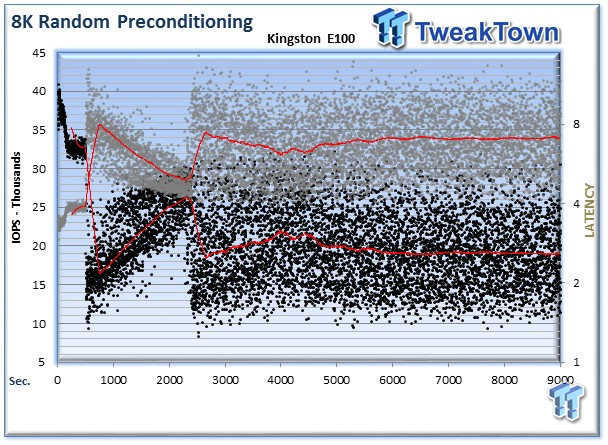
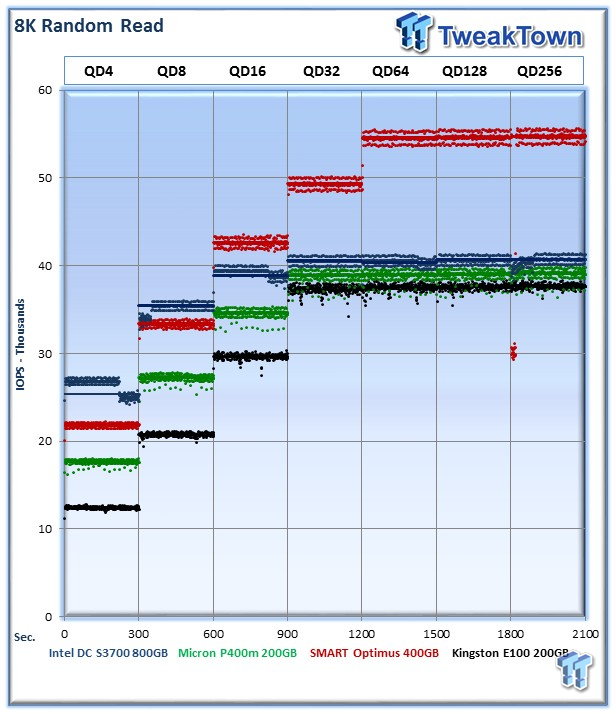
8K random read and write speed is a metric that is not tested for consumer use, but for enterprise environments this is an important aspect of performance. With several different workloads relying heavily upon 8K performance, we include this as a standard with each evaluation. Many of our Server Emulations below will also test 8K performance with various mixed read/write workloads.
The average 8K random read speed of the Kingston E100 comes in at 37,726 IOPS at QD256, which brings it directly underneath the Micron P400m and the Intel DC S3700. This is a great score for a SandForce-based SSD.
[img]20 [/img]The average 8K random write speed of the Kingston E100 is 19,104 IOPS at QD256. The wide performance variability is indicative of SandForce characteristics with partially compressible data.
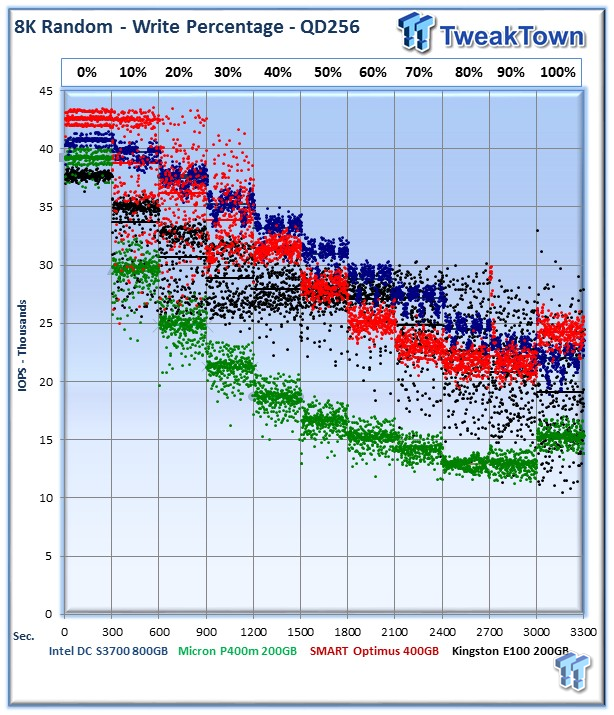
The Kingston E100 has a tighter performance range in comparison to its 4K write percentage-testing results. The Micron P400m is far more consistent, though its average dips below that of the E100 in the 30-90% write percentage fields.
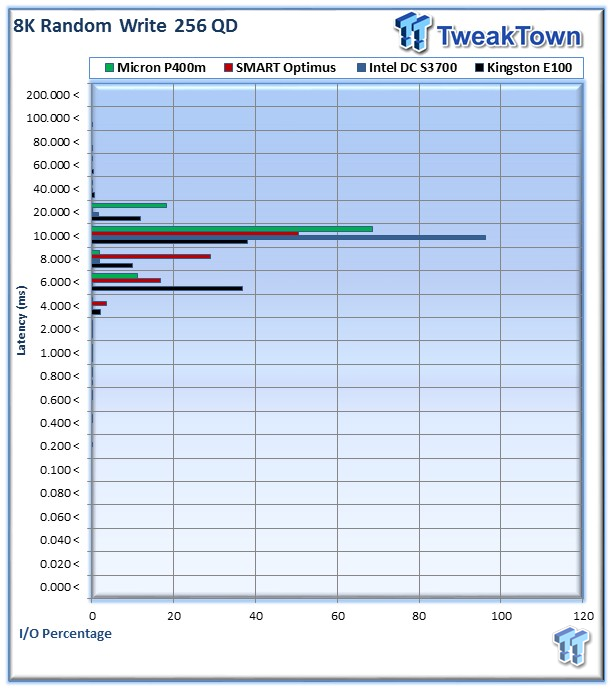
The Kingston E100 has a large percentage of its 8K write activity, 36.9%, land in the lower range of 6-8ms. 38.1% of I/O falls into the 10-20ms range, and 11.9% lands at 20-40ms. This latency variation closely mirrors the results in the performance testing. The entire latency range spans from .8-1ms to 100-200ms.

Power consumption for the Kingston E100 averages 4.02 Watts, slightly higher than the Micron P400m.
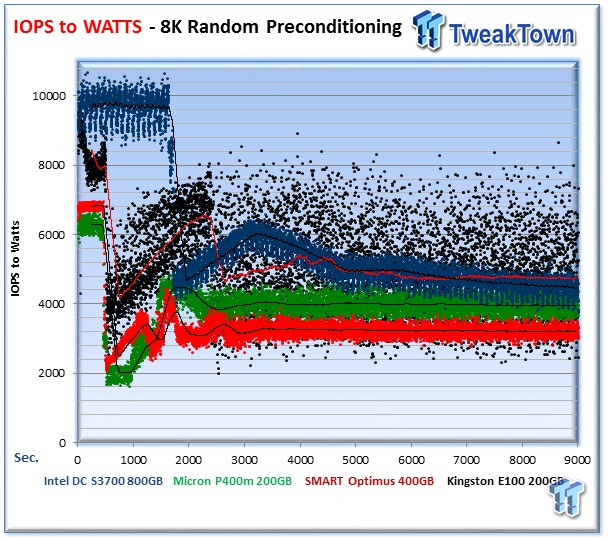
The E100 averages 4,739 IOPS per Watt, slightly higher than the rest of the test pool.
128K Sequential Read/Write
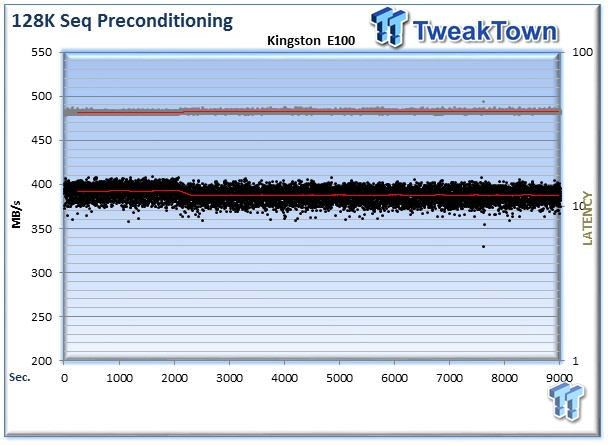
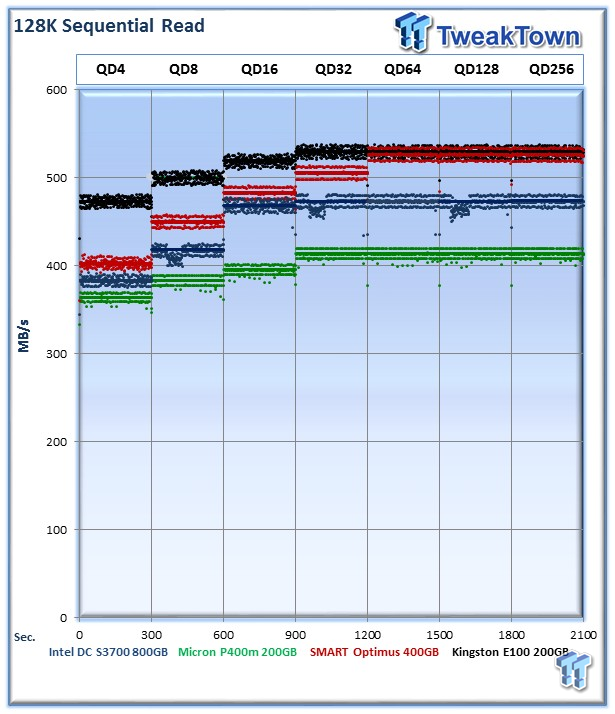
The 128K sequential speeds reflect the maximum sequential throughput of the SSD using a realistic file size encountered in an enterprise scenario.
The Kingston E100 averages 529 MB/s within a very tightly defined range, matching the SAS-powered Optimus.
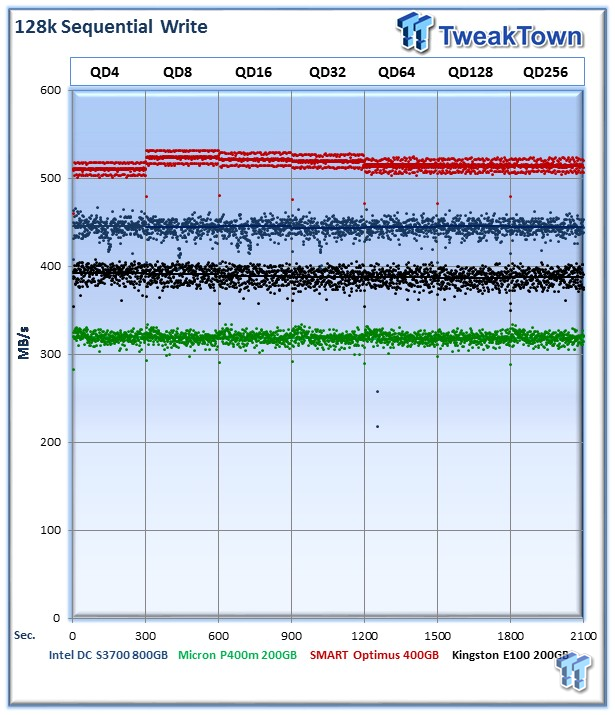
The Kingston E100 exhibits solid 128K write performance at an average of 387MB/s.
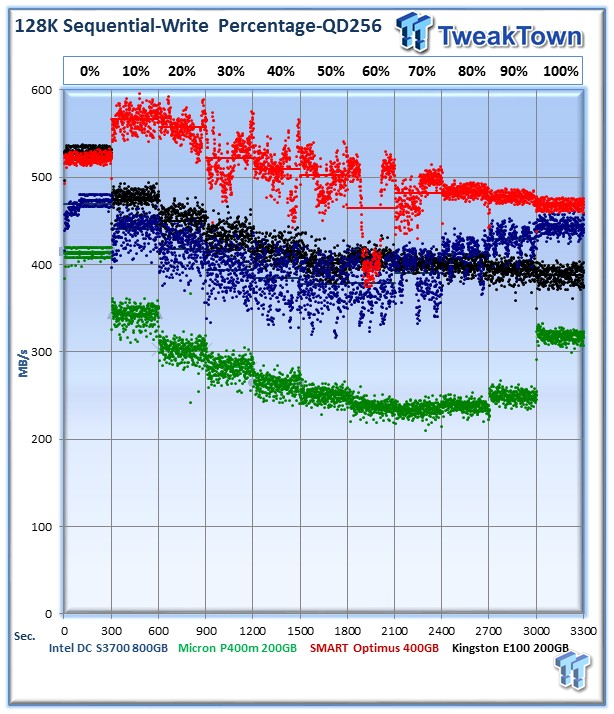
The Kingston E100 performs well in the 128K sequential write testing, falling just below the Intel DC S3700 with a pure write workload. The E100 manages to perform significantly better than the P400m in this testing.
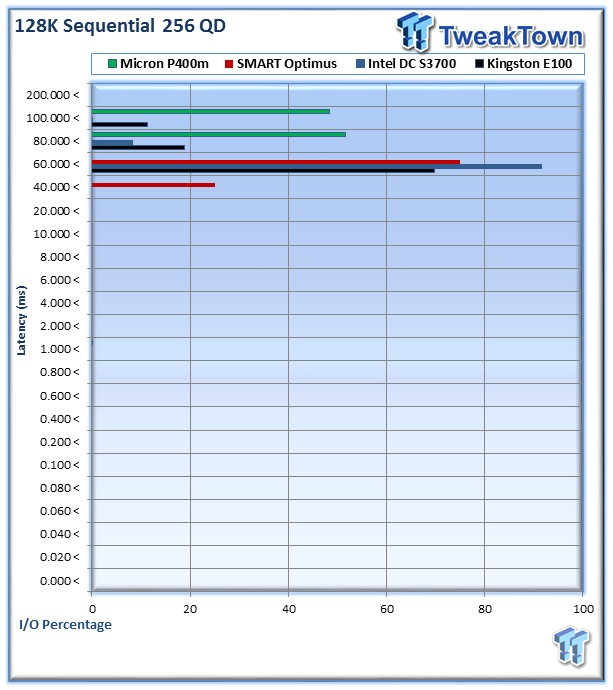
The Kingston E100 provides 647,638 I/Os (69.7%) at 60-80ms, 175,935 I/Os (18.9%) at 80-100ms, and 104,766 I/Os (11.2%) in the 100-200ms range.
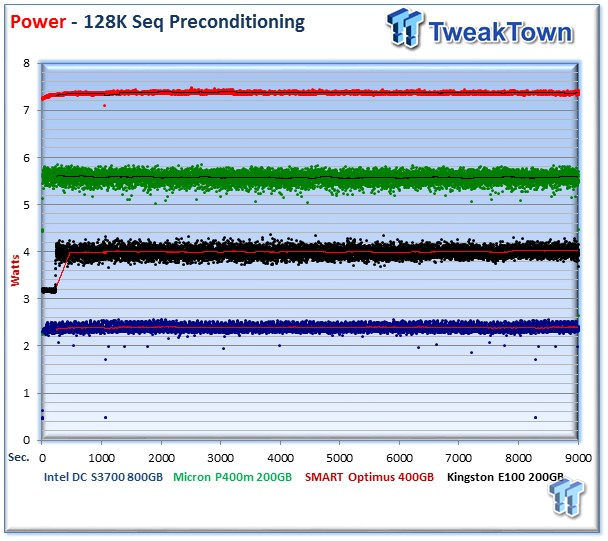
The E100 averages 4.23 Watts during sequential write testing.
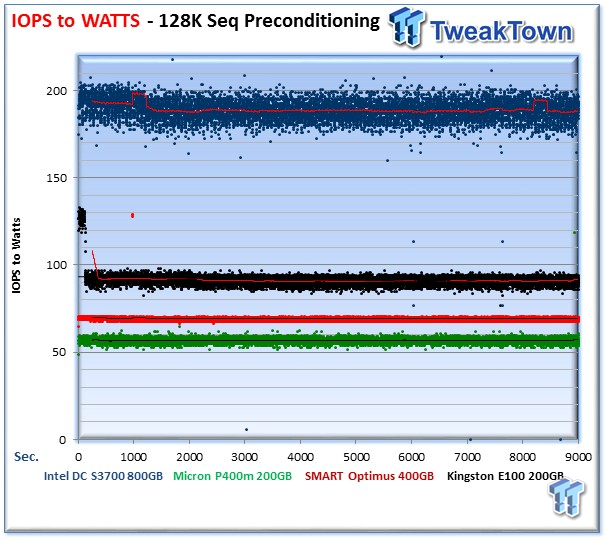
The E100 provides 91MB/s per Watt, below only the Intel DC S3700.
Database/OLTP and Webserver
Database/OLTP
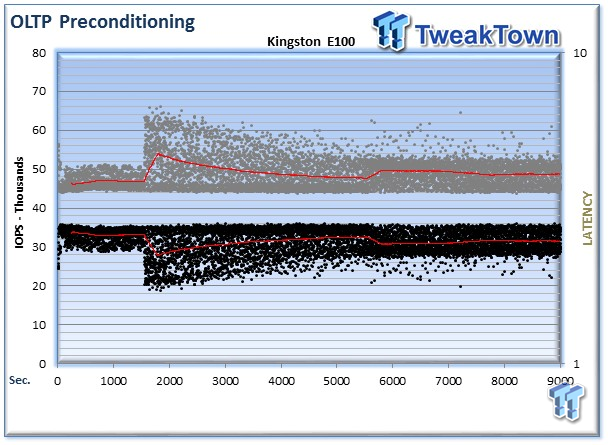
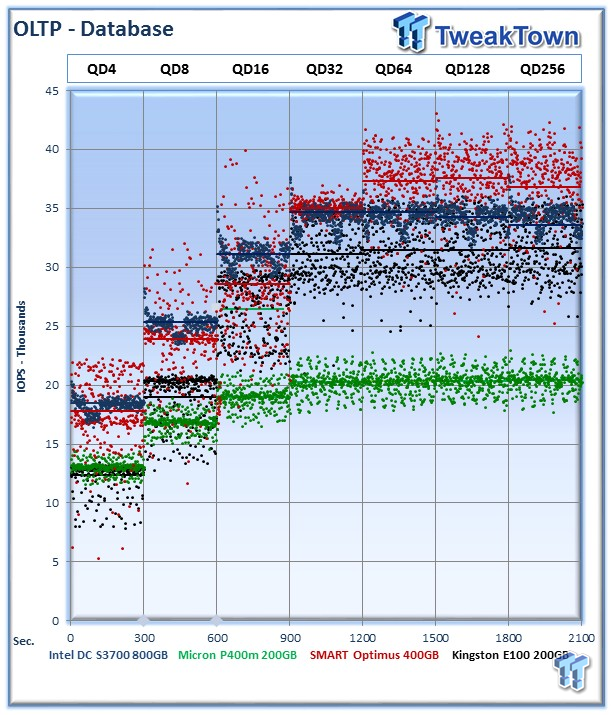
This test emulates Database and On-Line Transaction Processing (OLTP) workloads. OLTP is in essence the processing of transactions such as credit cards and high frequency trading in the financial sector. Enterprise SSD's are uniquely well suited for the financial sector with their low latency and high random workload performance. Databases are the bread and butter of many enterprise deployments. These are demanding 8K random workloads with a 66% read and 33% write distribution that can bring even the highest performing solutions down to earth.
As we begin to delve into our mixed workload benchmarks it is important to note, again, that we test the Kingston E100 with 50% compressible data. OLTP and Database workloads tend to be highly compressible, so in real deployment performance may be higher than represented in these tests. Other workloads we test may also tend to have different compression ratios, so it is important to understand the workload and adjust purchasing decisions accordingly.
The Kingston E100 averages 31,668 IOPS during the measurement window, with a similar amount of variability in comparison to the Optimus and the Intel DC S3700.
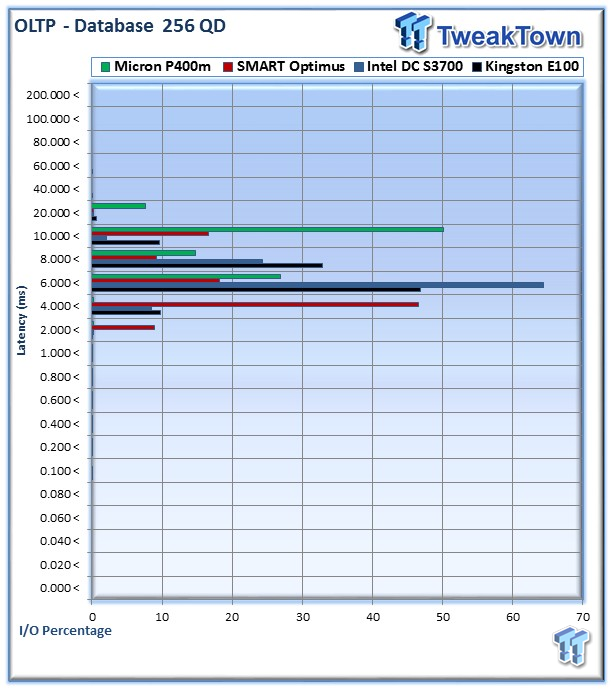
The Kingston E100 provides 4,431,590 I/Os (46.8%) at 6-8ms, and 3,114,547 I/Os (32.9%) at 8-10ms. There is a wide range of command latency for the E100, ranging from .2-.4ms to 60-80ms.
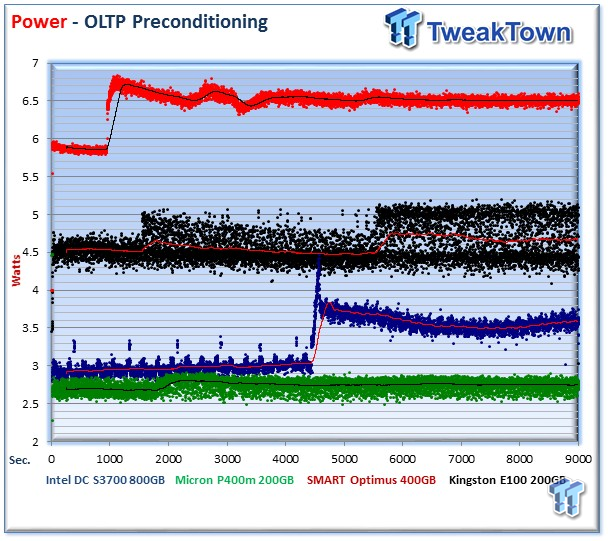
The Kingston E100 averages 4.66 Watts during the precondition run.
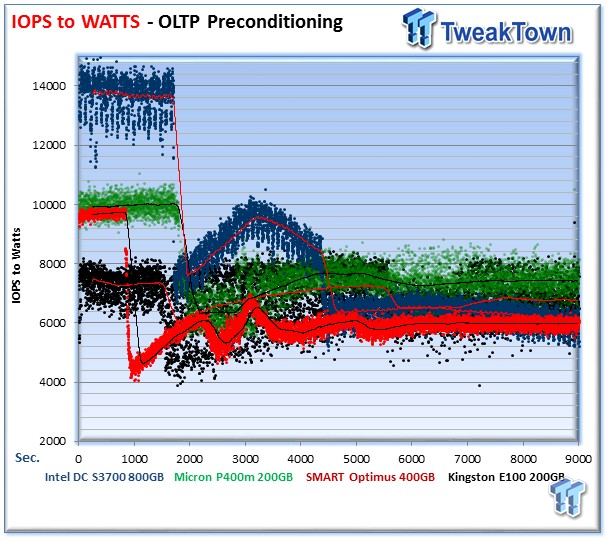
The Kingston E100 averages 6,777 IOPS per Watt, with the variability again lending some clutter to the chart. The Micron P400m averages 7,422, the Intel 9,418, and the Optimus 5,659 IOPS per Watt.
Webserver
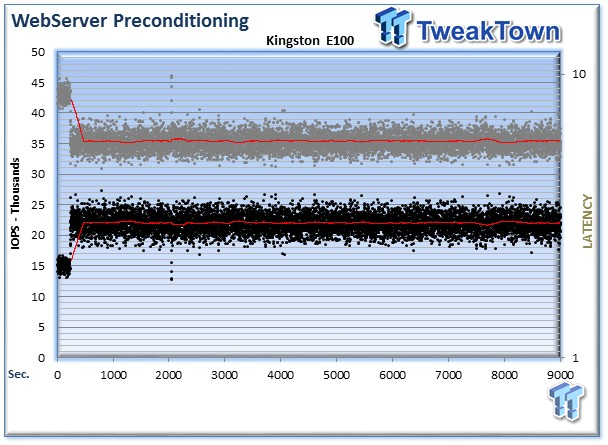
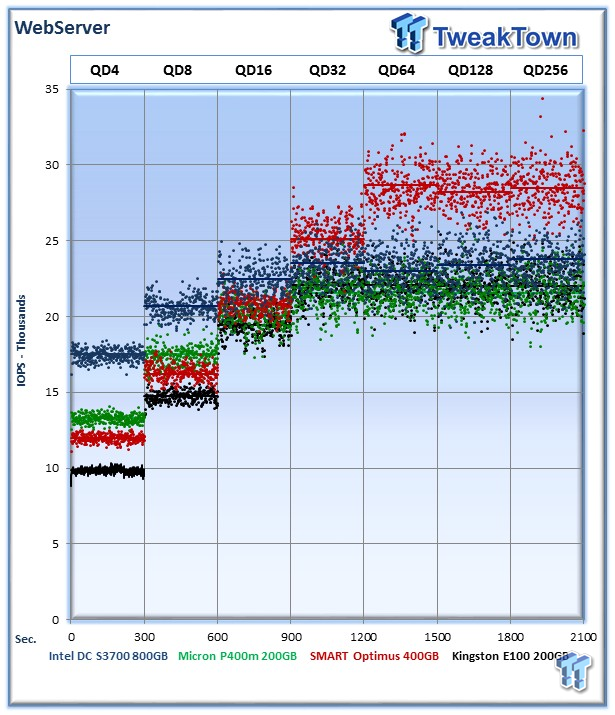
The Webserver profile is a read-only test with a wide range of file sizes. Web servers are responsible for generating content for users to view over the internet, much like the very page you are reading. The speed of the underlying storage system has a massive impact on the speed and responsiveness of the server that is hosting the website, and thus the end-user experience.
The Kingston E100 averages 22,042 IOPS, matching the Micron P400m and the Intel DC S3700.

The Kingston E100 provides 5,093,605 I/Os (77%) in the 10-20ms range, and 1,365,971 I/Os (20.7%) in the 8-10ms range.
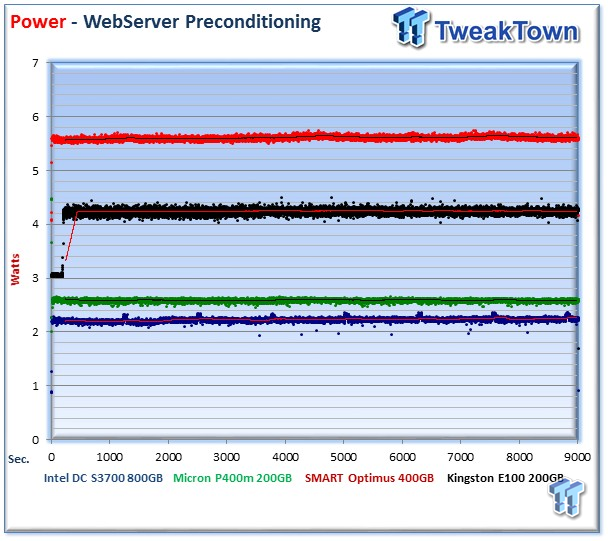
The E100 averages 4.01 Watts during the measurement window.
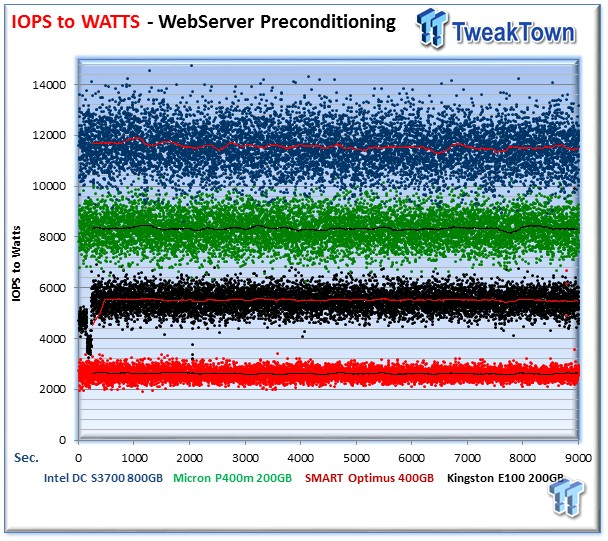
The E100 averages 5,471 IOPS per Watt.
Fileserver and Emailserver
Fileserver


The File Server profile represents typical file server workloads. This profile tests a wide variety of different file sizes simultaneously, with an 80% read and 20% write distribution.
The Kingston E100 averages 29,719 IOPS at QD256, which is again in the same performance range as the Intel and Micron SSD's.
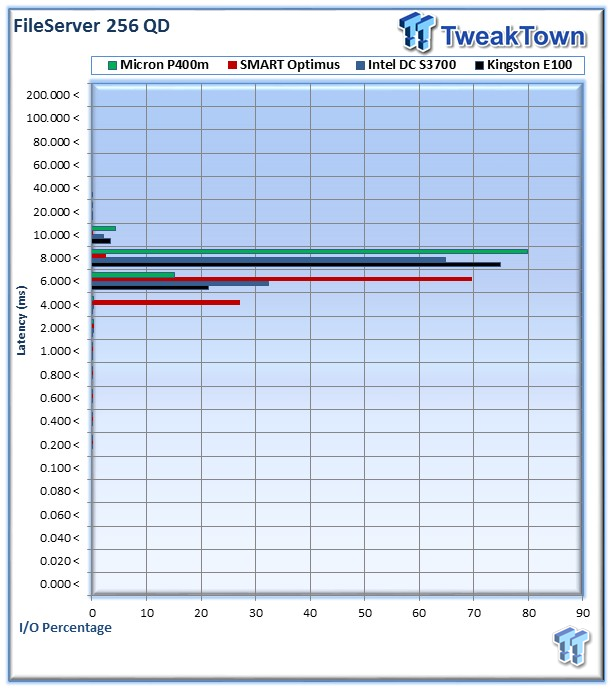
The Kingston E100 provides 6,650,588 I/Os (74%) in the 8-10ms range, and 1,905,531 I/Os (21%) in the 8-10ms range.
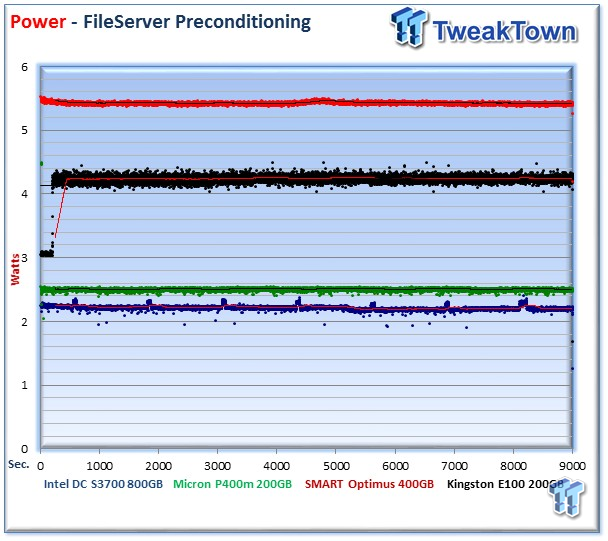
The E100 averages 4.23 Watts in steady state.
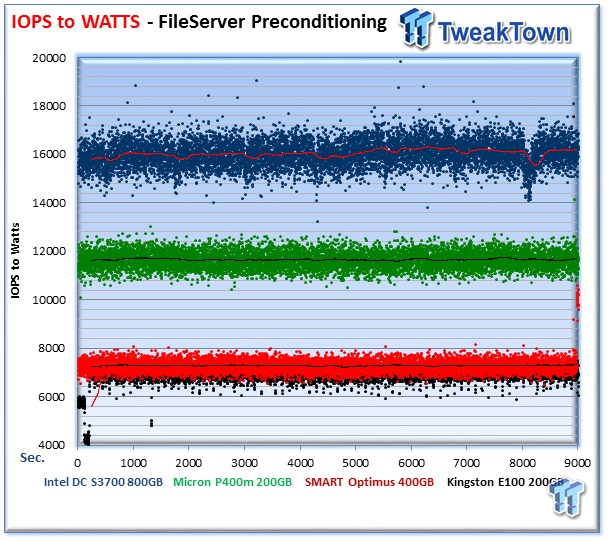
The E100 averages 7,053 IOPS per Watt, coming in very close to the Optimus average of 7,276 IOPS.
Emailserver
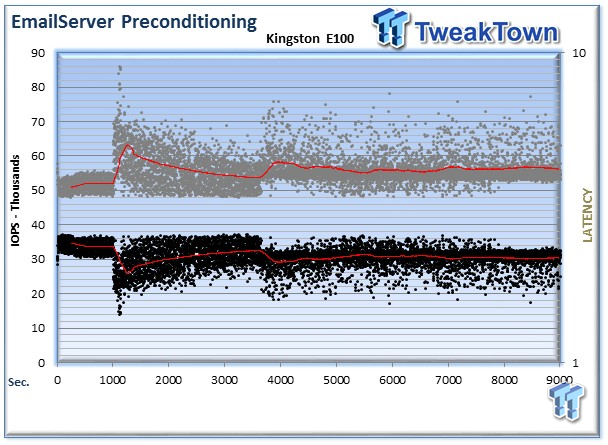
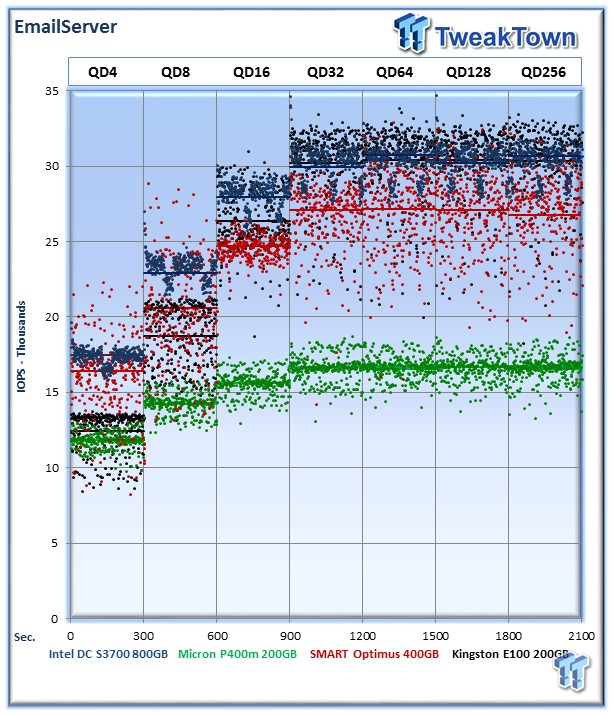
The Emailserver profile is a very demanding 8K test with a 50% read and 50% write distribution. This application is indicative of the performance of the solution in heavy write workloads.
The Kingston E100 exhibits excellent performance in this test, with 30,362 IOPS at QD256.
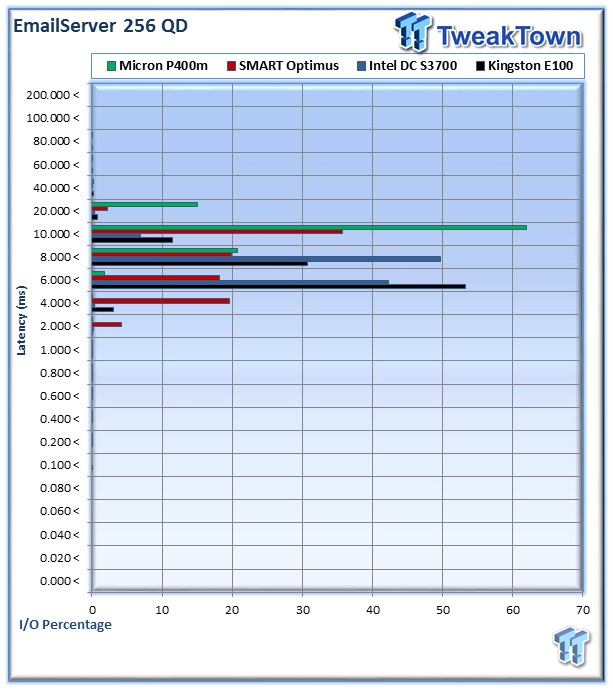
The Kingston E100 provides 53.2% of I/O's in the 6-8ms range, 30.1% at 8-10ms, and 11.5% at 10-20ms.
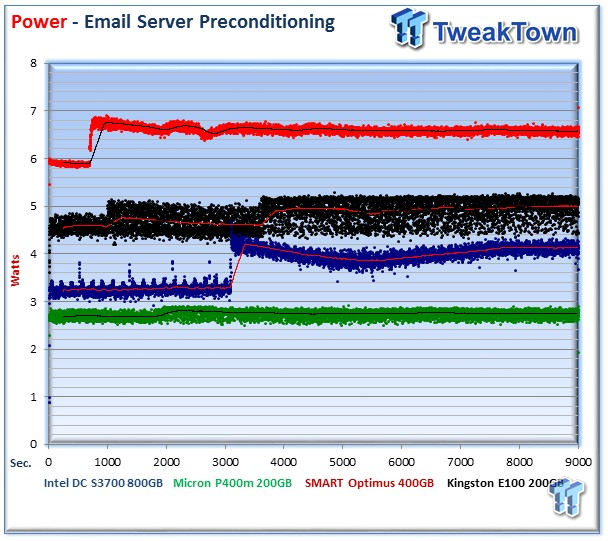
The E100 averages 3.46 Watts during the measurement window.
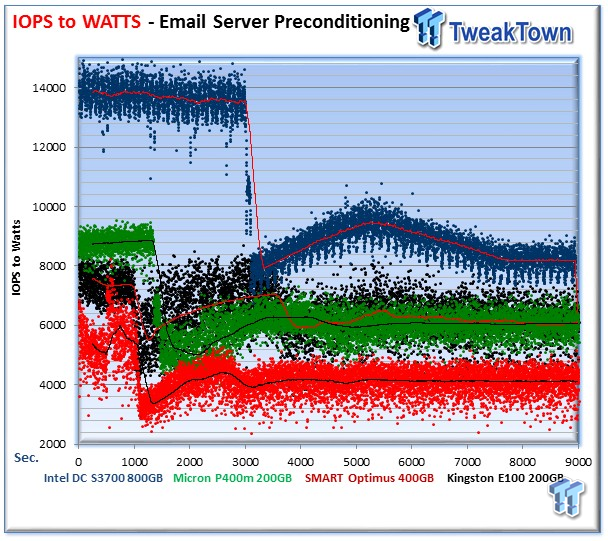
The Kingston E100 averaged 6,100 IOPS per Watt.
Final Thoughts

The Kingston E100 proved to be a solid competitor in our testing. LSI SandForce powered SSD's benefit greatly from compressible workloads, but do suffer some performance loss when dealing with incompressible data. The compression performance characteristics of SandForce SSD's are well suited to most enterprise deployments. We strive for the 'middle ground' by testing with 50% compressible data, but it is important for administrators to know their workload and to adjust their purchasing decisions accordingly.
The Kingston E100 surprised us with its performance in heavy write workloads, and in particular the performance in our Emailserver tests. This test consists of a very heavy write workload of 50% read and 50% write with an 8K file size, and the E100 really powered through the test and matched the performance of the top-flight enterprise SSD's currently on the market.
The write percentage testing also highlighted great performance with varying workloads, and we found the E100 to be very competitive on the efficiency front in our IOPS-to-Watt testing. In pure read workloads, the Kingston E100 performed exceptionally well. The only dark spot on the performance front was variability in the heavy write workloads. We found that this variability did not extend to the same degree in our server workloads.
This level of performance was impressive from the LSI SandForce processor, proving it still has the chops to deliver in the enterprise space. The Kingston E100's impressive performance against newer controller and hardware combinations was surprising in a few ways. The fact that the older controller can still deliver big is important, but also the fact that the other players are delivering such great performance with lower quality MLC is surprising as well.
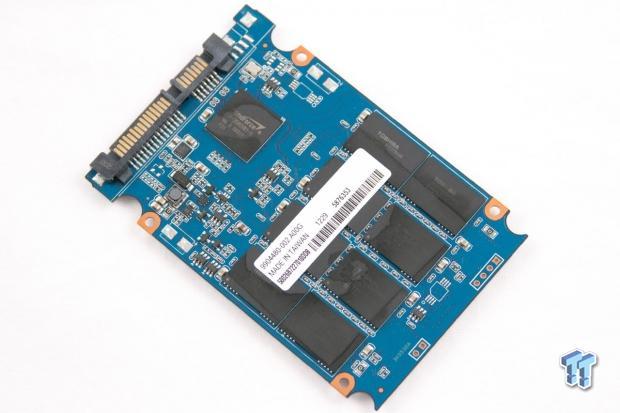
The E100 speaks volumes to the initial design and continuing firmware development from the LSI SandForce team. With our recent tests of SLC SandForce SSD's, we have observed that when paired with higher-quality NAND, the SandForce SSD's continue to deliver great performance. With a refresh of the SandForce series due in the coming months, it will be exciting to see if the new controllers can deliver higher performance than the competition.
One area where the Kingston E100 is not as competitive is pricing. The current price of the Kingston E100 hovers around $3.50 per GB. The concerted efforts of foundry players and their determination to gain market share is developing a cutthroat competition for rock-bottom pricing. It is also important to consider endurance. Others on the market are offering five year warranties - the Kingston E100 only features a three year warranty, limiting its competitiveness in the market.
One of Kingston's key differentiators has always been reliability and quality, which is well suited for the enterprise space. Excellent customer service is another key selling point that keeps Kingston's customers coming back. However, with a higher price range than competing solutions and a shorter warranty period, some may look elsewhere this time around.

